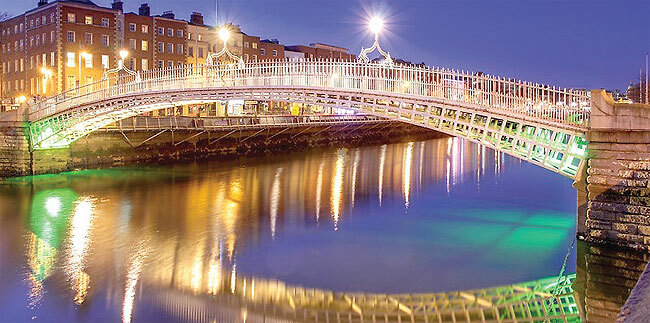Teachers to visit Ireland's 200-year-old Ha'Penny Bridge
The bridge is one of the products of the technological advances of the early Industrial Revolution.
PIC: An estimated 30,000 pedestrians cross the bridge every day. (Courtesy photo)
EDUCATION | TRAVEL

At the end of this month, five winners of New Vision's Teachers Making a Difference 2017 competition will travel to Ireland courtesy of the Irish embassy, Trocaire and Simba Travelcare, one of Uganda's leading tour and travel management companies. A number of sites have been lined up to make the teachers' experiences memorable. In a series of stories, we unveil for you the places they will be visiting while on this historic trip. We bring you the history of Ireland's oldest pedestrian bridge; the Ha'Penny.
Every single day, over 30,000 Dubliners cross the Ha'Penny, the oldest pedestrian bridge that singly provided the much-needed access for over a century until the completion of the Millennium Bridge in 1999.
Officially known as the Liffey Bridge, one of Dublin's iconic landmarks runs over River Liffey in the centre of Dublin. It has a 43-metre span, is three metres wide and three metres above the river. The bridge is primarily composed of three parallel arch ribs, one on each side and one in the centre.
Each arch rib consists of six length pieces, which are connected at each joint by six bolts through a single continuous plate. The section shape of members is cruciform, offering greater resistance than a flat plate.
Compression forces are taken by deflection of the arch, while tension forces would be taken by the six bolts at the rib joints. It is recorded as one of the first iron bridges in the world, a thoroughbred from the great ironworks of Coalbrookdale.
It is one of the products of the technological advances of the early Industrial Revolution. The 200-year-old Ha'Penny derives its name from the toll that was levied when it was first opened. The tollman asked for half a penny. It was built as a replacement of the seven ferries that used to cross Dubliners from one side of the R. Liffey to the other.
These had since become dilapidated and the proprietor was given two choices; either to renovate them or build a bridge. Up until 2012 when the authorities cited maintenance risk to the bridge, lovers had, like on most famous bridges, turned the Ha'Penny into a point of celebrating love and romance.
Here, they placed padlocks (love locks) bearing their names or initials and threw the keys into the water. It is an act symbolic of unending love. It has been described as the most popular spot for proposals in Dublin.

Over 300kg of metal love locks were removed from the bridge and the authorities have since banned the practice. The number of pedestrians using the Ha'Penny has dramatically increased over the years from the 400 when it first opened in 1816, to the current 30,000.
It is this increased traffic, coupled with other technical factors, that informed the Ha'Penny's first major renovation in 2001, costing over £1.3m.
Much of its original fabric, especially the cast iron and design, were maintained. For tourists such as the teachers, there is just a lot to indulge in around the Ha'Penny. The bridge is kept abuzz by the traditional Irish bars and restaurants, the bridge market, comedy and art centres, among other things.
Just close by is the Bachelors' walk, one worth just strolling on, regardless of your marital status. The Liffey River passing below the bridge gives tourists an uninhibited view of the Ha'Penny.
FACTS AND STATISTICS
- An estimated 30,000 pedestrians cross the bridge every day.
- 85% of the original rail work was retained during the refurbishments in 2001.
- It was the only pedestrian bridge over the river for 184 years until the completion of the Millennium Bridge.
- The bridge is also known as Liffey Bridge and the Iron Bridge.
(Source: www.bridgesofdublin.ie)
ABOUT TEACHERS MAKING A DIFFERENCE
The Teachers Making a Difference competition is part of the Ugandans Making a Difference project, initiated by New Vision in April 2008. The project aims at recognising and rewarding those individuals who have innovatively used limited resources to make a positive impact in their communities. New Vision has always implemented the project either singly or in partnership with institutions that share similar objectives. The initiative followed the success of the annual Women Achievers Awards launched in 2005. While the Women Achievers' project targets women, Teachers Making a Difference focuses on all professional teachers innovatively delivering the school curriculum from preprimary to advanced level of education, including technical and vocational training institutions.
(This story was first published in the New Vision newspaper of Wednesday, January 17, 2018)